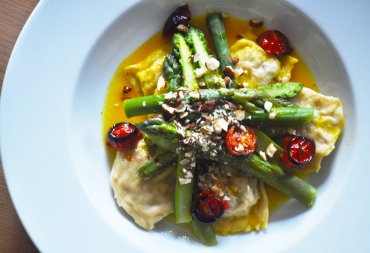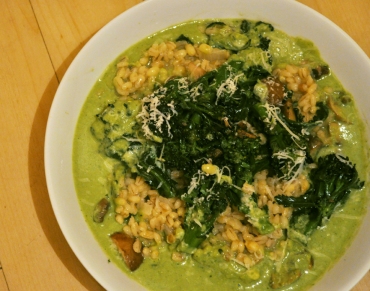It’s still the season for British asparagus (and yes, I believe it’s running slightly late this year, along with much of nature). Today we used up some local asparagus spears to accompany a homemade ravioli filled with a mix of black salsify, hazelnuts and ricotta. It’s a variation on a theme by our old favourite Denis Cotter, with a few ingredients changed, and it was rather delicious. I’ll write up more about homemade pasta soon but in the meantime, here’s what we did for this dish.
Serves two.
First, the ravioli filling: preheat the oven to 180c. Peel and dice around 100g of black salsify and boil in a small saucepan until tender. Scatter the salsify on an oven tray and place it in the warm oven to ‘dry out’ a little for around 10 minutes (you don’t want a soggy filling in your ravioli). After removing it, mash it with a fork. Leave the oven on.
Blitz 25g of hazelnuts in a food processor and transfer to a bowl, mix in the salsify mash, a large dessert spoon of ricotta, a large pinch of grated or ground nutmeg, season with a little salt and pepper and combine well. Set aside.
Now for a little ‘sauce’: squeeze the juice of half a lemon into a small pan, add some strips of lemon peel and 50ml of white wine plus a pinch of saffron strands. Bring to a simmer and let it cook for 3 minutes. Remove the strips of peel and add around 30g of unsalted butter. Stir until it melts. Keep this warm, but don’t let it boil.
Filling the pasta: a general way of making the ravioli is with two equal size sheets of thinly rolled pasta dough. Take the first and carefully place teaspoons of the filling on it, around 2.5cm apart. Brush the pasta with water or egg wash and place the other sheet on top. Press it down, making sure there are no air bubbles. Now use a ravioli cutter or knife to cut out square ravioli.
The asparagus: we used thick spears, woody ends snapped off, cut lengthways. Thinner ones can be left whole.
The tomatoes: slice a handful of cherry tomatoes in half and place them on an oven tray, drizzle with olive oil, season with a little salt and place in the oven.
Now bring it all together. First put the asparagus in a saucepan of boiling water and simmer for around 5 minutes until just tender. As it’s cooking, cook the ravioli for around 4 minutes in a large pan of salted water. Drain, return to the pan and add the lemon butter. Stir.
To serve, place the ravioli in wide bowls, place the asparagus on top, pour over any remaining lemon butter, add the tomatoes and finish with a scattering of chopped hazelnuts.







Ways with tofu
A few weeks ago I was asked about tofu: do you like it and what do you do with it? A few years ago I would have said I didn’t like it one bit, but all that’s changed. Why? Well, eating tofu in the Vietnamese restaurants of Kingsland Road and its environs in London, for one thing. And, also, wising up to the fact that tofu comes in differing textures: from ‘silken’ and soft versions to firm. Our ETP tofu cooking requires the bean curd to be knocked about in a pan so we look for the firm varieties. Sometimes we marinade it first and sometimes we don’t. Sometimes we chop it up into bite-size pieces and sometimes we slice a block into a large slab. Smaller pieces become more crispy when fried – good for throwing into soups and for dishes where there is a fair bit of sauce. The large slabs, while crisping at the edges, also retain a soft centre, which can make for an appealing contrast of textures. A distant memory makes me want to liken tofu in our dishes to pork crackling. But I could be wrong – all that is more than half a life ago.
Below we have two recent examples of tofu dishes we’ve made. First, chopped to bite size, is an earthy tofu dish with broccoli, shiitake mushrooms and noodles. Below that is a fragrant marinated tofu dish with oyster mushrooms, salad and rice.
There are some other ideas for tofu on this site too (you do use the ingredients list to search out recipes, don’t you?) Have a look here, here and https://earthtoplate.wordpress.com/2011/06/18/last-nights-dinner-tofu-with-lemongrass-and-chilli/.
Posted in Asia, Comment, Recipes, Tofu, Vietnam | Leave a Comment »